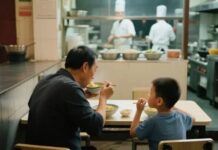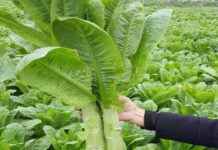After more than 10 years of “romance” with 100 breeding horseshoe crabs, Mr. Tran Minh Quan, Tan Thanh Hamlet, Nhon Nghia Commune, Phong Dien District, Can Tho, is now the owner of a prestigious breeding and meat horseshoe crab farm in Can Tho.
Mr. Tran Minh Quan is also the head of the Quan Tien horseshoe crab Cooperative with 20 members, supplying thousands of breeding and meat horseshoe crabs to the market each year.

Mr. Quan (in white shirt) instructs techniques for those in need of raising horseshoe crabs. Photo: Thu Hien/TTXVN
Talking to Dan Viet, Mr. Quan said that before 2011, he raised soft-shelled turtles. However, at that time, the price of soft-shelled turtles was low, and moreover, soft-shelled turtles often get sick, especially when they are young. Therefore, Mr. Quan is no longer interested in raising soft-shelled turtles.
In 2011, Mr. Quan boldly switched to raising horseshoe crabs although his family’s financial conditions did not allow it.
“I was introduced to horseshoe crabs by an acquaintance and learned that they are easy to raise and less prone to disease, so I switched to raising them from 2011 until now. I remember that at that time, I had to borrow money to have enough 50 million VND to buy 100 breeding horseshoe crabs”, Mr. Quan recalled.
Thanks to his previous experience in raising soft-shelled turtles, Mr. Quan found that raising horseshoe crabs was easier, with less cost of feed, so Mr. Quan boldly raised more for breeding.
Now, Mr. Quan has 200 horseshoe crab breeders. Raising horseshoe crabs for reproduction in a cement tank, Mr. Quan divides it into small compartments, each containing 4 female and 1 male horseshoe crabs, and makes a place for horseshoe crabs to lay eggs.

After about 2 years of breeding, horseshoe crabs reach a weight of about 3kg/crab and are sold for 400,000 VND/kg. Photo: Dan Viet.
The breeding season of horseshoe crabs usually begins from the 12th lunar month to the 7th lunar month every year. Each year, a mother horseshoe crab lays 3-4 clutches of eggs, each with 8-15 eggs. After collecting the eggs, Mr. Quan takes them to incubate for 100-105 days to hatch. The young horseshoe crabs are then raised for over 60 days before being sold as breeding stock.
“In my cement tank, a breeding horseshoe crab weighs from 20-25kg, lays 3-4 clutches a year, and 1 clutch is from 15-18 eggs. After collecting the eggs, I take them to incubate for 100-105 days to hatch, the success rate is over 90%”, said Mr. Quan.
According to Mr. Quan, horseshoe crabs are sold after more than 60 days old, because it will reduce diseases, avoiding waste for the breeder. Each year, Mr. Quan sells 2,000 breeding horseshoe crabs to the market at a price of about 350,000 VND/crab. The buyers come from different provinces and cities across the country.
According to TTXVN, in addition to raising breeding horseshoe crabs in cement tanks and selling breeding horseshoe crabs, Mr. Quan also invests in ponds for raising horseshoe crabs for meat to supply the market. Currently, every day, in Mr. Quan’s pond, there are always 300-400 meat horseshoe crabs available for sale to customers. On average, Mr. Quan earns about 1 billion VND per year from selling breeding crabs and meat horseshoe crabs.

Thanks to the large volume and high price, when successfully raised, horseshoe crabs can bring in high profits. Photo: Thu Hien/TTXVN
Seeing that Mr. Quan’s horseshoe crabs bring in high economic efficiency, many neighboring households also bought back breeding stock and were enthusiastically guided by Mr. Quan on raising techniques. At the same time, Mr. Quan also takes care of the output for horseshoe crab farmers.
Thanks to the large volume and high price, when successfully raised, horseshoe crabs can bring in high profits, especially when farmers produce their own breeding stock. Horseshoe crab farming both meets market demand and increases farmers’ income.
Horseshoe crabs are a type of reptile belonging to the turtle family that lives mainly in the water areas of the South, and is quite similar in shape to soft-shelled turtles, also known as Southern soft-shelled turtles. However, the Southern soft-shelled turtle has the distinct feature of having 2 “nails” on either side of the head. Horseshoe crabs are wild animals and are listed in the Vietnam Red Book. Individuals and organizations that want to raise horseshoe crabs must have a permit.
Raising horseshoe crabs is not too difficult. Horseshoe crabs only need to be fed 2 times a day (morning and afternoon) with food such as snails, duck intestines, and tilapia. When horseshoe crabs are small (about 2cm), the water must be changed every day. Horseshoe crabs can be raised for 2 months or more, and then the water can be changed every 2-3 days. When the horseshoe crabs grow up, the water needs to be changed every 1-2 weeks.
In the first year, horseshoe crabs grow slowly, but in the following years, they grow quickly. After about 2 years of breeding, horseshoe crabs reach a weight of about 3kg/crab and are sold for 400,000 VND/kg. If horseshoe crabs are raised as breeders, it takes 3 years to start breeding.
From the effectiveness of the horseshoe crab farming model, in 2023, the Farmers’ Association of Nhon Nghia commune mobilized 20 households raising horseshoe crabs to establish the Quan Tien Horseshoe Crab Cooperative.
With a total farming area of about 5,000m2, the Quan Tien Horseshoe Crab Cooperative currently supplies the market with about 4,000 breeding horseshoe crabs and 4 tons of meat horseshoe crabs.
According to Director of the Cooperative Tran Minh Quan, the current number of breeding and meat horseshoe crabs of the cooperative is still not enough to meet the market demand, especially in Hanoi.
Horseshoe crab meat is rich in nutrients and can be processed into many delicious dishes: stir-fried, cooked with sour rice, steamed with ginger… To diversify products and meet market demand, the Cooperative also makes frozen horseshoe crab meat to serve small and medium customers at a price of 800,000 VND/kg.
In addition, the Director of the Cooperative also invested in ponds to “store” commercial horseshoe crabs collected from Cooperative members in time for customer orders.
Up to now, Can Tho City has 170 agricultural cooperatives, of which only Nhon Nghia has a cooperative that raises horseshoe crabs.
Commenting on the economic efficiency that horseshoe crabs bring to farmers, according to Mr. Tran Thanh Hieu, Chairman of the Farmers’ Association of Nhon Nghia commune, raising horseshoe crabs does not require much space and time, and the cost is low and easy to raise. Even households with a small land area can still raise horseshoe crabs.
According to the current market assessment, there is still a lot of potential for horseshoe crabs. Therefore, the Farmers’ Association will continue to mobilize the expansion of the number of members raising horseshoe crabs in order to increase the output of horseshoe crabs to meet market demand.
































